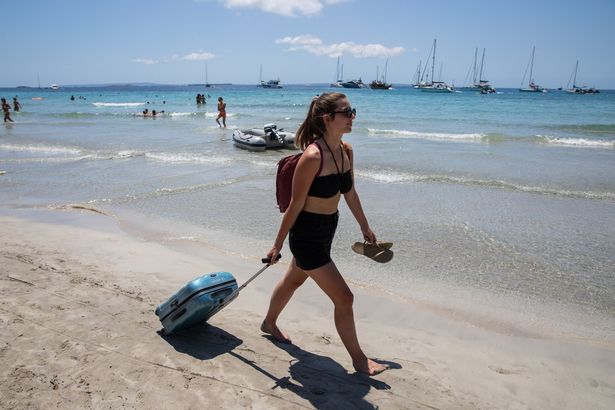Spanish holiday hotspots are considering tighter coronavirus regulations after record levels of new cases were reported over the last few weeks.
Spain is still on the UK’s amber travel list, with Mallorca and Ibiza having just lost their green status due to the growing number of infections.
The Balearic Islands, the Canaries and the Costa del Sol are all reporting new record levels of coronavirus and are considering bringing back night-time curfews if they can persuade the courts to reverse a decision that ruled they were unnecessary.
In the Balearics, the regional government is working with experts to prepare a raft of restrictions to include new limitations on the number of people who can meet up.
On Friday, the islands notched up a record number of infections with 864 new cases in 24 hours.

(Image: Getty Images)
A total of 6,050 people currently have coronavirus and the cumulative incidence in the last 14 days is 513.5 cases per 100,000 inhabitants. Menorca continues to be the island with the highest incidence with 1,050 cases per 100,000 inhabitants. In Mallorca, the rate is 454.5 cases. There were no new deaths, with the total standing at 846.
Despite hopes being pinned on vaccinations, the government has called in a health team to prepare new regulations which are being described by the islands’ press as “a step back in de-escalation” and “sky rocketing”.
At this stage, a new curfew on the islands is being ruled out but measures are likely to try and avoid large groups of people and earlier closing for restaurants and bars, currently set at 2am. A night-time curfew was recently vetoed by the Supreme Court, both in the Balearics and the Canary Islands.
“The analysis will include an exhaustive study on which sectors the infections occur in, whether or not the virus affects those vaccinated and to what extent it and how the tracking work is progressing, much more difficult than in previous waves because now there is much less collaboration of citizens, who are reluctant to say who their close contacts have been,” reports Ultimahora.es today. “The hospital situation, which is the thermometer in which restrictions are measured, will also be taken into account. ”

(Image: Getty Images)
Last week, Balearic president Francina Armengol said the crucial data would be hospital occupation, not the coronavirus incidence. Although hospital pressure has increased, the situation is not even near critical.
The government will also be looking at the vaccination rates, with half of the population having already received their jabs.
“Vaccination changes everything,” Francina Armengol said last week on Twitter.
And yesterday, she said: “As cases increase, the hospital situation is under control but we cannot lower our guard.”
The Balearic government says it wants to carry out full consultation before proposing any new measures and will talk to all the individual councils across all the islands. Meantime, current rules in place will continue which include a ban on the sale of alcohol in shops and garages after 10pm in a bid to stamp out illegal raves and parties in the streets and parks.
Nightclubs and discos remain closed.

Video Unavailable
Hoteliers are reporting holiday cancellations from Brits following the Balearic’s return to the UK’s amber list but government officials say there are still many families willing and able to travel who will fill the gap.
Two of the most popular holiday islands in the Canaries have also been placed on a higher coronavirus alert due to the increase in cases over the last few weeks.
Popular haunts with the Brits, Fuerteventura goes to alert level 3 and La Palma to level 2.
For the time being, Tenerife continues at level 3 but is facing going up to the top level unless the infection rated decreases; Gran Canaria remains at level 2 and La Gomera, El Hierro, Lanzarote and La Graciosa, at level 1.
The new levels came into force yesterday following a meeting of the Canary government and on the advice of health chiefs.
Fuerteventura recorded 352 cases of Covid between June 30 and July 13th which represents an average of 25 daily cases. The seven-day accumulated incidence rate (AI) has been rising from high to very high risk on July 9th, while the risk indicator for the elderly population presents a medium risk level.
“There have been no deaths, no ICU admissions, and hospital occupancy due to COVID is at minimal risk,” said a Ministry of Health spokesman. “However, the situation associated with the outbreaks, their characteristics and their extension, together with the marked and rapid rise in the level of transmission, suggest that, in order to control transmission, the island is raised to alert level 3.”
On the island of La Palma, between June 30 and July 13, 139 cases were diagnosed, ten during the first week of the fortnight and 129 in the most recent week, presenting an accumulated incidence rate at seven days of 111.4 cases per 100,000 inhabitants, at a high-risk level.
The rate in the population aged 65 or over is at a low-risk level, with 18.1 cases per 100,000 inhabitants, while hospital occupancy, conventional beds and ICUs are also at minimal risk. Hence, level 2 was agreed.
“The rest of the islands remain at the level established the previous week, but all of them are under epidemiological surveillance due to some important increases and the appearance of outbreaks,” said the spokesman. “Both in the case of Tenerife and Gran Canaria, the report states that, although they remain at the alert level they had, the indicators suggest that in the short term it is not ruled out that the higher alert level has to be established.”
The Canary government has also decided to appeal against a Supreme Court decision that failed to back its request for a new 12.30am to 6am curfew for islands at level 3 or 4 in a bid to control illegal raves and beach parties.
A judge said there was no evidence there was more risky behaviour at night than in the day but the government says it feels this is the way to control infections being spread by young people who have not yet had their Covid vaccinations.
All of the Canary islands still have restrictions in force, including time and capacity restrictions on pubs, restaurants and shops.
On the Spanish mainland, Andalusia is studying limiting alcohol sales hours, avoiding mass events and closing beaches in municipalities that in 14 days exceed 1,000 cases per 100,000. Parks and gardens may be closed and a curfew may be reintroduced. Police checks will also be stepped up to make sure shops, restaurants and pubs are complying with coronavirus regulations.
Andalusia has seen its coronavirus rate soar to 314, an increase of 100 in a week.
Marbella has an incidence rate of 854 infections per 100,000 people in the last fourteen days and is approaching the 1,000 threshold where a new perimeter closure could come into force.
In Catalonia, the courts have approved a new night-time curfew for 161 towns. The region has the highest case rate in Spain – 1,100 per 100,000 residents in the last 14 days.
The regional High Court yesterday greenlighted a 1am-6am curfew requested by the Catalan government for the 161 municipalities with the highest transmission risk. The measure will remain in effect for a week, until July 23, when regional authorities are due to update the list of affected locations.
The northern region of Navarre also wants to impose a 1am-6am curfew in municipalities with a 14-day incidence of over 250 cases per 100,000, beginning on July 21.
In the Valencia region, the executive has secured court backing to restrict social gatherings to a maximum of 10 people and to introduce curfews in places with high infection levels.
And in the Basque Country, social gatherings of people from different households have been banned and crowds prohibited between midnight and 6am in order to avoid street parties and binge drinking.
In Spain as a whole, the 14-day national incidence of the virus is now above 500 cases per 100,000 inhabitants once more, with hospital admissions doubling in two weeks. This is the highest level since February.
The latest health report on Thursday showed 27,688 new infections and added 41 victims to the overall death toll.


